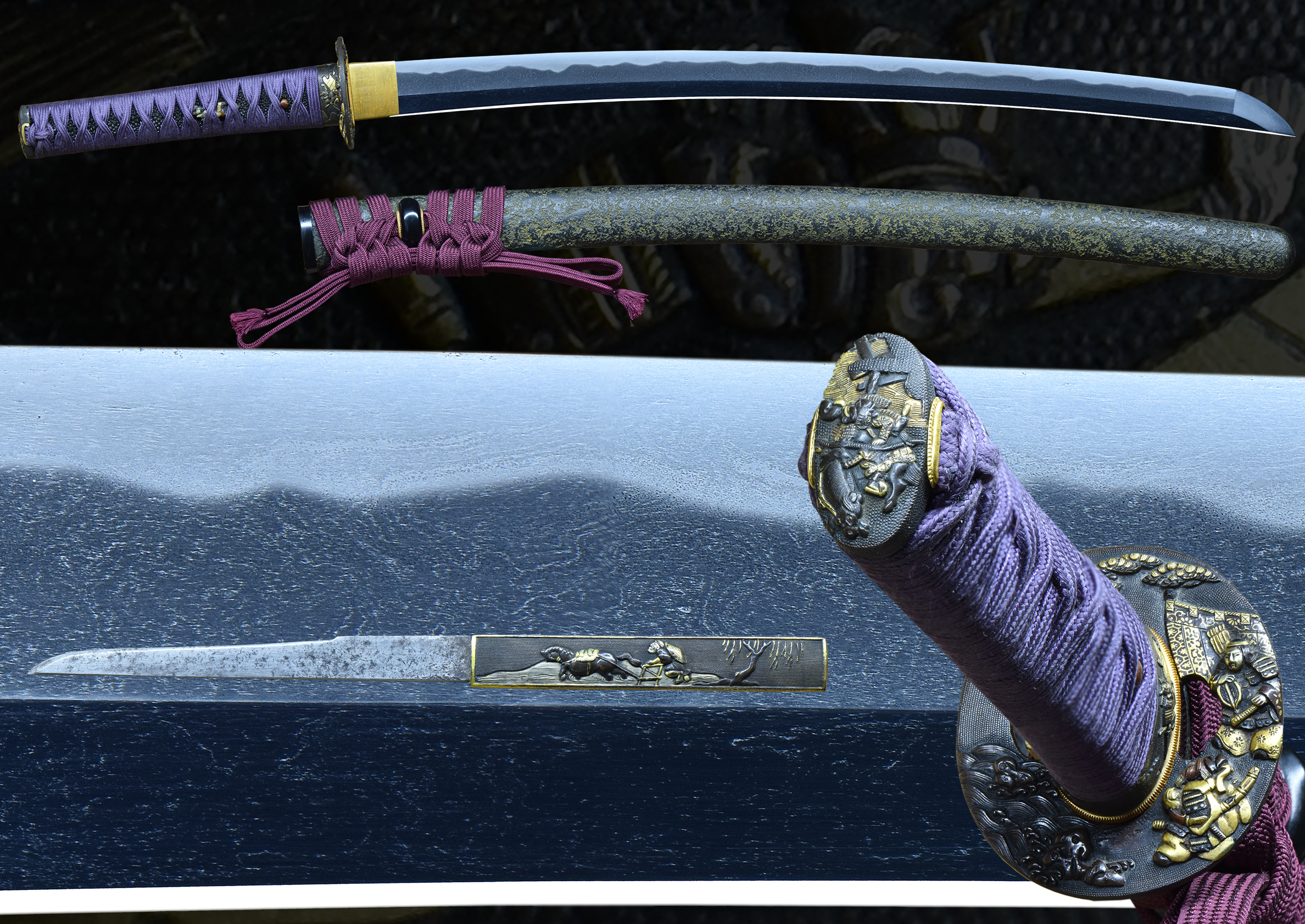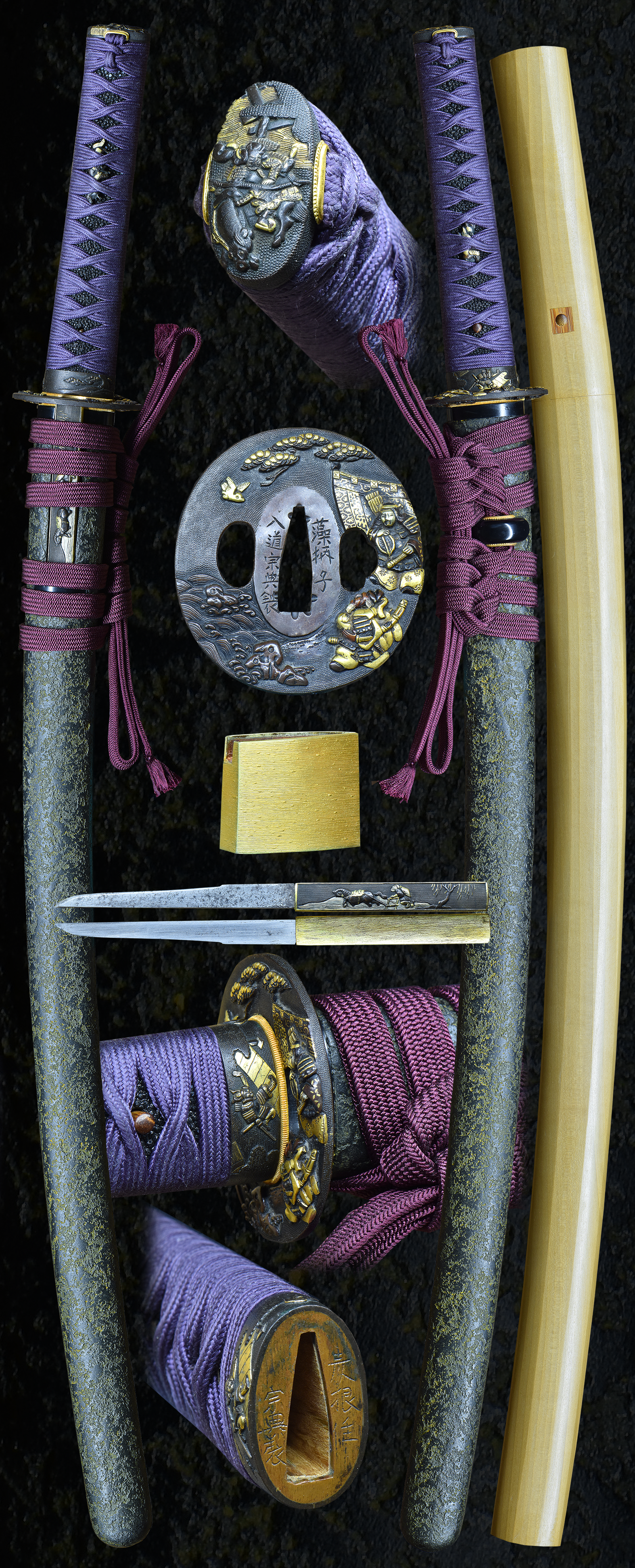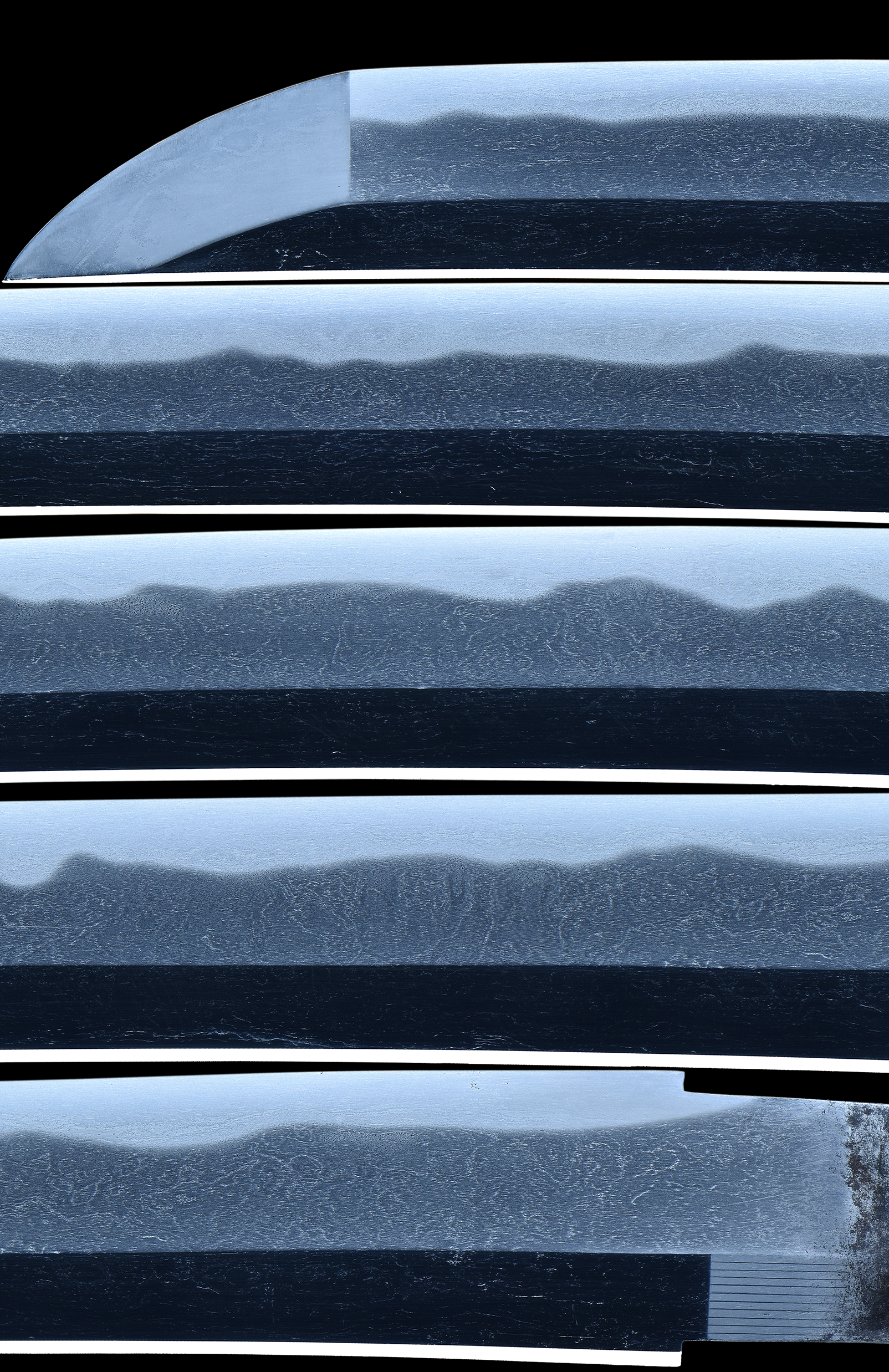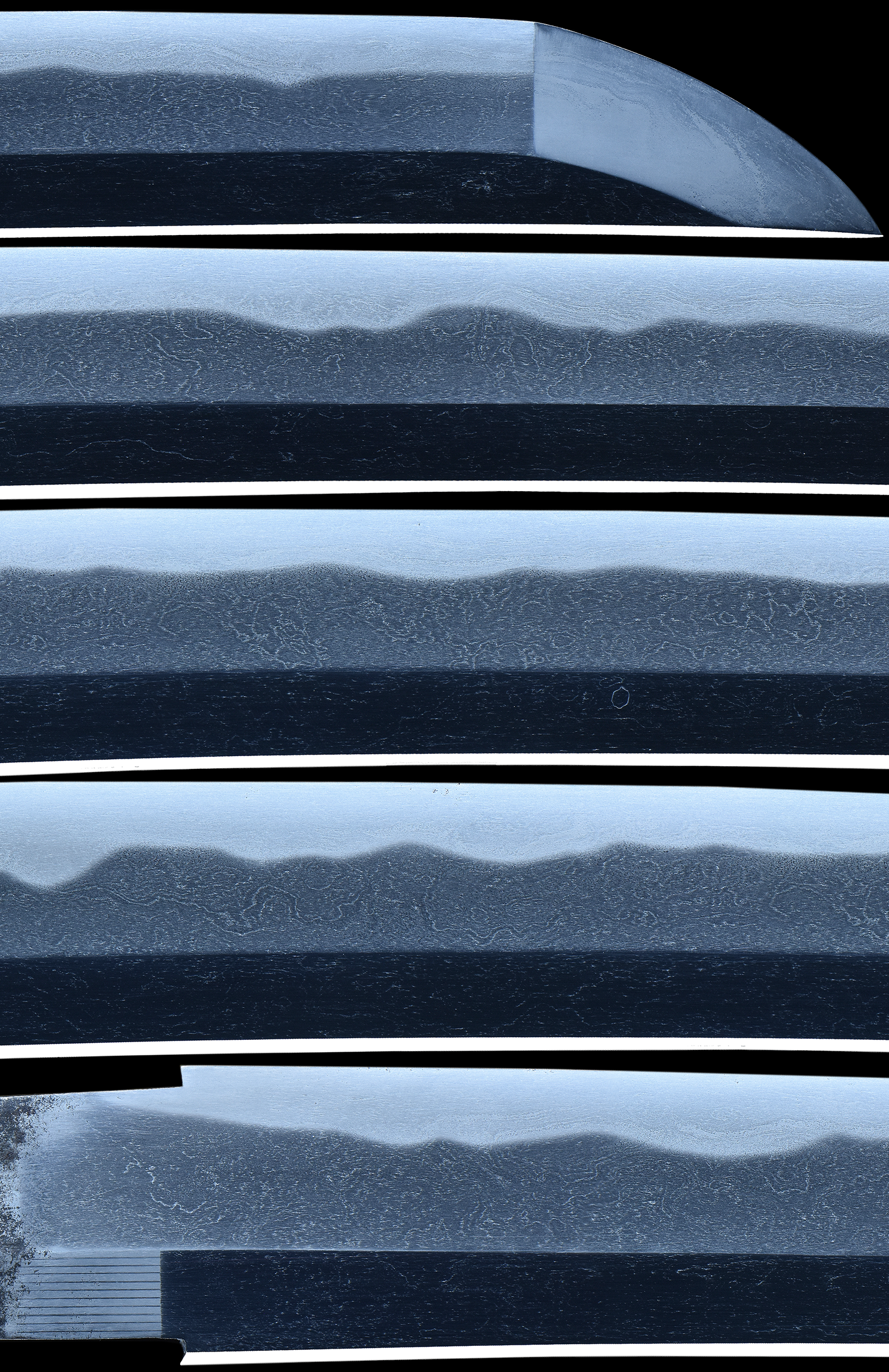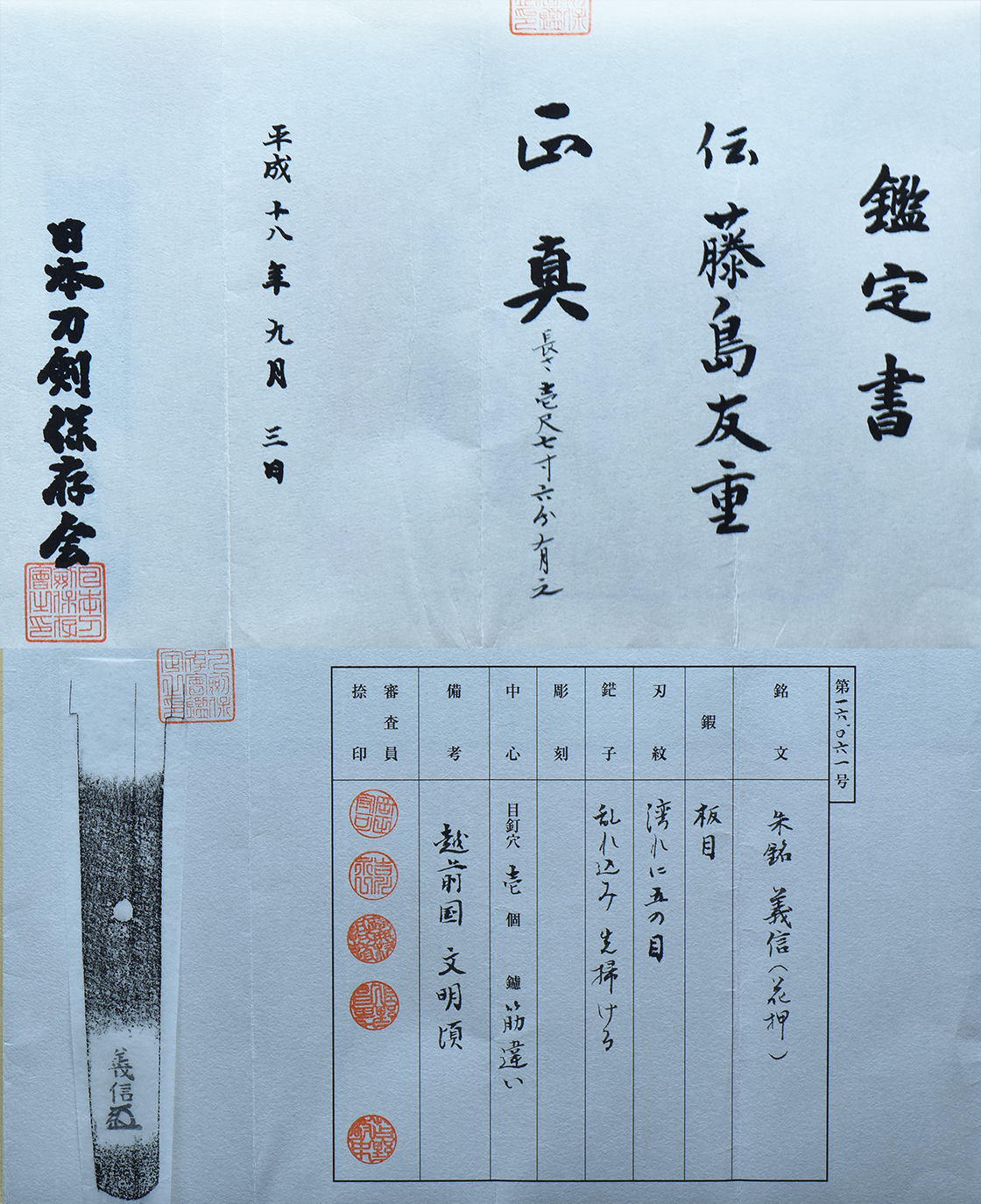This sword was awarded the kanteisho prior to polish. It received an attribution to TOMOSHIGE. There is a red Shumei at the bottom of the tang attributing it to YOSHINOBU. This blade if resubmitted may be attributed to an even higher ranked smith now that its in pristine polish but it’s not a necessity. The hada is a beautiful swirling mix of itame and mokume loaded and covered in ji-nie. Chikei abounds! The hamon is nie laden with brilliant streaks of sunagashi and kinsuji. The boshi is Kaen with hakikake. The koshirae is equally impressive. The saya is in a Ishime finish. The fittings are all adorned in a motif of samurai and horses. The Nanako is very nice on the tsuba. The tsuka ito is a bright orchid color over a black lacquered same (rayskin). The sageo is a purplish red hue. The seppa are gold washed. The kodzuka is of a man with horse in fields. The Habaki is gold foiled and is of high quality also.
This Koto era sword comes with NTHK KANTEI-SHO papers.
A koto period wakazashi by the Fujishima Tomoshige line of smiths who had ten generations of the name during the Koto period and six generations up until the Shintoshinto period. A splendid wavy gunome togariba majiri hamon (temper line) typical of the Fujishima School captures the eye and imagination. Hailing from the artistic province of Kaga (now Kanazawa), the Fujishima School is considered one that combines characteristics of the five major traditions. Fujishima school is a descendant of Rai school that moved to Gaga province. They were active during early Muromachi period to late Edo Period. The jigane is black and the hada patten could be seen clearly. The hamon looks like Bizen swords at first glance however, there is much Shirake fog like Utsuri appearing and boshi is midarekomi style in many of the blade. They have nice deep sori as well.
FUJISHIMA TOMOSHIGE DEN
Fujishima is the name of a place in Echizen Province and it is said that the first generation of Tomoshige lived here first then moved to KagaProvince later. The founder of the Fujishima school was Tomoshige, a pupil of Rai Kunitoshi. His work dates to 1334-1338. Smith is Fujishima Tomoshige-mono or majiwari-mono. The characteristics of the swords of the Fujishima school tend to combine the traits of two or three of the Gokaden (five main schools). Some said that it brings Yamato and Soshu styles to mix. Certain of the Fujishima smiths, and the later Sanekage school smiths, worked in one or more of the basic traditions and incorporated several of the characteristics of these schools into their work. Tomoshige and Nobunaga tempered gunome-midare with sunagashi in nie-deki which reminds one of Sue-Bizen smiths and Nobukuni of Yamashiro Province. I have seen sugu-ha of Tomoshige and gentle notare of Nobunaga with hotsure and sunagashi. They normally forged ko-itame-hada or ko-itame-hada combined with masame. I have seen pure masame-hada by Nobunaga. Tomoshige occasionally makes wakizashi and tanto in kanmuri-otoshi-zukuri that was favoured by Yamato smiths. There are some extant works with the mei of ‘Fujishima Yukimitsu’. Yukimitsu tempered notare-midare and Kiyomitsu favour tempering chu-sugu-ha and hiro-sugu-ha, rather than gunome-midare. The production age of the extant works by Kiyomitsu is limited to the Genki and Tensho Eras.
- Mei: Mume, Attributed to Fujishima Tomoshige
- Date: Bunmei (文明, 1469‒1487)
- Nagasa: 21 inches
- Sori: 15.0 mm
- Width at the ha-machi: 32.6 mm
- Width at the yokote: 23.4 mm
- Thickness at the mune-machi: 8.3 mm
- Construction: Shinogi zukuri
- Mune: Iori
- Nakago: Ubu
- Kitae: Itame/mokume
- Hamon: Midare Gunome
- Boshi: Kaen with hakikake
- Condition: Great polish
(shipping and insurance included)
Email us if your interested in this item and remember to include the order number for this item: fss-902.
Click to Enlarge Image
Click to Enlarge Image
Click to Enlarge Image
Kantei-sho (鑑定書) ‒ Appraisal
Den Fujishima Tomoshige (伝藤島友重) ‒ Attributed to Fujishima Tomoshige
Shōshin (正真) ‒ Authentic
nagasa 1 shaku 7 sun 6 bu kore ari (⻑さ壱尺七寸六分有之) ‒ Blade length ~ 53.3 cm
Heisei 18 nen 9 gatsu 3 nichi (平成十八年九月三日) ‒ September 3, 2006
Nihon Tōken Hozon Kai (日本刀剣保存会) ‒ NTH
No 16061
meibun (銘文) ‒ Signature: shu-mei: Kanenobu + kaō (兼信「花押」)
kitae (鍛) ‒ Forging: itame
hamon (刃紋) ‒ Hardening: notare with gunome
bōshi (鋩子) ‒ Hardening in tip: midare-komi with hakikake at the tip
chōkoku (彫刻) ‒ Engravings:
nakago (中心) ‒ Tang: mekugi-ana (目釘穴) 1, yasurime (鑢): sujikai
bikō (備考) ‒ Remarks: Echizen province, around Bunmei (文明, 1469‒1487)
shinsaʼin natsuʼin (審査員捺印) ‒ Seals of Judges: 5 seals
For Sale





















